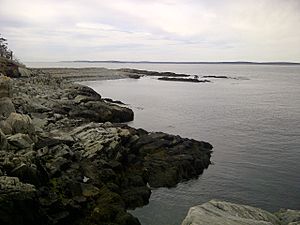Long Island (Nova Scotia) facts for kids
Long Island is a Canadian island found in Digby County, Nova Scotia. It is located in the Bay of Fundy, a famous bay known for its very high tides.
Long Island sits southwest of an area called Digby Neck. Another island, Brier Island, is just to its west. Long Island is separated from Digby Neck by a narrow water channel called "Petit Passage." It is separated from Brier Island by another channel called "Grand Passage."
You can travel the length of Long Island using Route 217. This road connects two ferry crossings. On the eastern side, a ferry at Tiverton takes you to East Ferry on Digby Neck. On the western side, a ferry at Freeport connects to Westport.
Island Features
Long Island is about 15 kilometers (9 miles) long and 5 kilometers (3 miles) wide. It is mostly made of a type of rock called basalt. This rock is part of the North Mountain ridge.
The southern coast of the island, facing St. Mary's Bay, has tall, steep cliffs. The northern coast, facing the Bay of Fundy, has smaller cliffs and beaches made of round rocks. There are several small bays, called coves, along both sides. Some of the well-known coves include Bear Cove and Israel's Cove (also known as Pirate's Cove) in Tiverton, Flour Cove in the center of the island, and Beautiful Cove in Freeport.
In the middle of the island, there are two shallow lakes close together. A small stream flows from these lakes in two directions, ending at either end of the island, one near Tiverton and the other near Freeport.
The Bull Tidal Bore
A special natural event called a tidal bore happens in St. Mary's Bay. This occurs just south of Petit Passage when the tide is going out (called an ebb tide). This powerful rush of water is commonly known as The Bull.
History
The explorer Samuel de Champlain first found Long Island in 1604. However, people did not start living there until the late 1700s. At that time, land was given to British loyalists. These were people who supported the British during the American Revolution against the Americans.
What People Do Here
The main industry on Long Island is lobster fishing. The lobster season usually runs from the last Monday in November until the end of May.
Tourism is also a growing industry. The Bay of Fundy is famous for whale watching. Many tour operators on Long Island offer whale watching trips during the summer months.
Another popular attraction is Balancing Rock. This is a large column of basalt rock that looks like it is perfectly balanced on its end. You can find it on the southern shore, just outside Tiverton.
Wildlife
Long Island is home to various animals. You can often see deer and many types of sea birds. In 2013, a bear was seen on the island, which was surprising because bears had not been seen there for about a century. Sometimes, if you are lucky, you can even spot whales from the water's edge.
Images for kids




